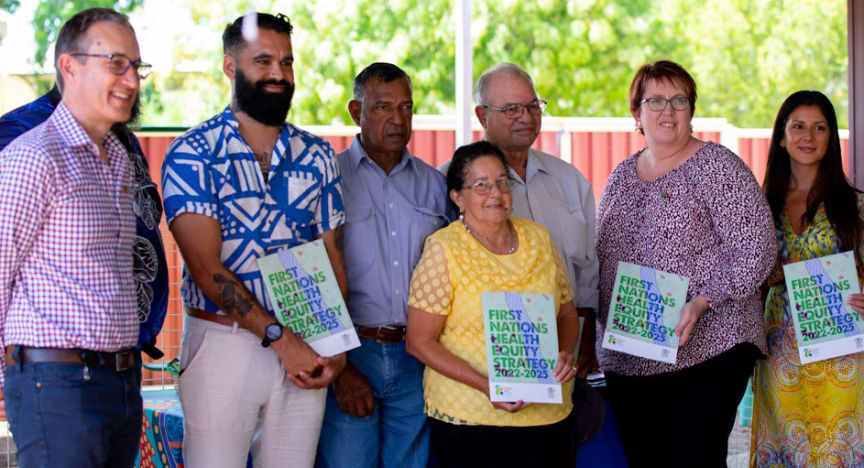
A historic document to improve the health outcomes for Aboriginal and Torres Strait Islander people in Central West Queensland will be launched on 8 November in Longreach.
Central West Hospital and Health Board Chair Jane Williams said the health service had been undertaking consultation on its First Nations Health Equity Strategy since early this year.
“Along with other health services in Queensland, Central West Health is dedicated to improving the health and wellbeing of our Aboriginal and Torres Strait Islander communities,’’ she said.
“To do this well, the health system must deliver culturally responsive, equitable and appropriate care, no matter where you live.
“It is completely unacceptable that Aboriginal and Torres Strait Islander people continue to die on average 10-12 years earlier than non-Indigenous people.
“This population is also more likely to have multiple illnesses, low birthweight babies, poor mental health, diabetes and renal failure and are less likely to be immunised.
“We need to turn this around and that is what our new Health Equity Strategy is designed help us do.
“But achieving this requires much more than the provision of clinical services, it requires us to have an understanding and respect of cultural differences and needs, and a commitment to applying this understanding across all areas of the health service.
“Our health service is very excited to embark on this journey to improve health and equity outcomes in partnership with our First Nations communities.’’
Ms Williams said the Central West First Nations Health Equity Strategy would focus on six priority areas:
- Improve First Nations health and well-being outcomes
- Actively eliminate racial discrimination and institutional racism
- Increase access to better health services
- Deliver sustainable, culturally safe, and responsive healthcare services
- Influence the social, cultural, and economic determinants of health
- Work with First Nations peoples, communities, and organisations to design, deliver, monitor,
and review health services
Central West Health Executive Director of Aboriginal and Torres Strait Islander Health Dan Carter said the Health Equity Strategy had been codesigned with the community, health professionals and other key stakeholders in the region.
“This strategy can only succeed if we harness the expertise and wisdom of our local community through ongoing meaningful engagement and consultation,” he said.
“Closing the Gap is not something that can be done by the public health system alone because the reasons for poor life-expectancy are complex. Community backing is vital to achieving better health outcomes.
“We are strongly committed to improving our services for Aboriginal and Torres Strait Islander residents and to delivering them in culturally appropriate ways.
“About eight per cent of our residents in the Central West, identify as Aboriginal or Torres Strait Islanders, with the greatest proportion amongst people aged up to 14 years.
“Given the young age of many of our Aboriginal and Torres Strait Islander residents, we also must be able to resonate with and connect with young people, quite separately from older First Nations men and women.
“Communicating appropriately and effectively with this younger demographic is one of the priorities of our new health equity strategy.’’
Mr Carter said the next step following the launch of the strategy would be to start consultation on strategy implementation phase activities.
He said the Central West First Nations Health Equity Strategy was co-designed in partnership with First Nations people who were invited to participate in two extended yarning phases.
Yarning was undertaken both face-to-face and online.
- First phase yarning: 90 adults and 4 children canvassed, including 57 Traditional Owners and community members and 4 children.
- Second phase yarning: 59 Adults and 13 children canvassed, including 43 Traditional Owners and community members and 13 children.
NOTE
A local artwork created especially for the document by Tambo artists and proud Bidjara women Aunty Ann Russell and daughter Deann Frousheger provides a common illustrative thread throughout the Central West Health Equity Strategy.
The artwork, Coming Together, tells a story that links the delivery of health services with First Nations culture.
The artwork shows the fine line connection that runs between the local communities linked by the local river system and the medical professionals that visit the region.
The meeting places connected together in the artwork represent the towns in the Central West district – all linked with the river system.
The handprints represent the local services that are in the communities.
The footprints represent the visiting health professionals that come to the communities.
The animal prints are emu, kangaroo, and echidna tracks, while the border represents the continued communication between all the Central West communities.
The Central West Hospital and Health Service First Nations Health Equity Strategy will be launched at the Central Queensland Indigenous Development offices at 39 Duck St, Longreach, from 10 am to 12 noon on 8 November. Morning tea and lunch provided and there will be a Welcome to Country by Iningai Elder Tony Weldon.
The full strategy can be accessed here.